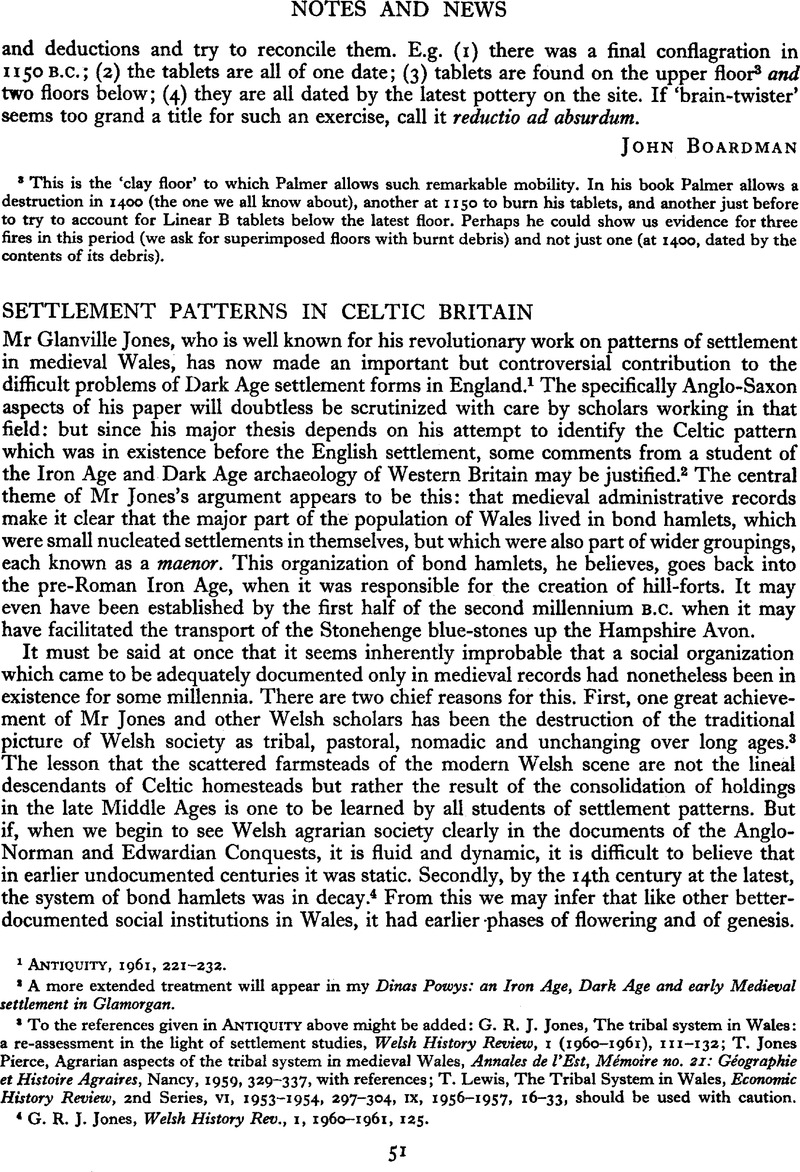Article contents
Settlement Patterns in Celtic Britain
Published online by Cambridge University Press: 26 May 2015
Abstract

- Type
- Notes and News
- Information
- Copyright
- Copyright © Antiquity Publications Ltd 1962
References
1 ANTIQUITY, 1961, 221–232.
2 A more extended treatment will appear in my Dinas Poviys: an Iron Age, Dark Age and early Medieval settlement in Glamorgan.
3 To the references given in ANTIQUITY above might be added : G. R. J. Jones, The tribal system in Wales : a re-assessment in the light of settlement studies, Welsh History Review, 1 (1960–1961), 111–132; Pierce, T. Jones, Agrarian aspects of the tribal system in medieval Wales, Annales de l’Est, Mémoire no. 21: Géographie et Histoire Agraires, Nancy, 1959, 329–337,Google Scholar with references; Lewis, T., The Tribal System in Wales, Economie History Review, 2nd Series, 6, 1953–1954, 297–304, ix, 1956–1957, 16–33,Google Scholar should be used with caution.
4 Jones, G.R.J., Welsh History Rev., 1, 1960–1961, 125.Google Scholar
5 Savory, H.N., Bulletin of Celtic Studies, 17, 1956–1958, 302–303.Google Scholar
6 A fuller discussion of this will appear in Foster, I.L. and Alcock, L. (eds.), Culture and Environment, 1962.Google Scholar
7 The hill-forts cited in Agricultural History Review, vin, i960, 80, are between 2 and 4 miles from the territorial centres which they are said to adjoin.
8 Published examples are Carreg-y-Llam, , Archaeologia Cambrensis, 106, 1957, 45–55,Google Scholar and Emrys, Dinas, Arch. Camb., 109, 1960, 13–77 Google Scholar; the publication of Gam Boduan, Dinas Powys and Deganwy is forthcoming.
9 Antiquaries Journal, XI, 1931, pl. IV.
10 Mr Jones probably overestimates the technical competence of ‘Iron Age husbandmen’ (a very wide term) ‘to deal with the heavier soils of the lowlands’. For the limited occurrence of coulters in Iron Age Britain, cf. Aberg, F.A., Gwerin, 1, 1956–1957, 171–181.Google Scholar
11 Proceedings Prehistoric Society, xv, 1949, 163–165.
12 Cunnington, M.E., The Early Iron Age inhabited site at All Cannings Cross Farm, Wiltshire, Devizes, 1923, 116–131.Google Scholar
13 Contrast the proven existence of nucleated villages in the continental homelands of the Anglo-Saxons during the Roman Iron Age. It should be added that the documentary evidence for the nucleation of Welsh bond hamlets is not earlier than c. 1200. The statement that ‘the small nucleated hamlet… provided a uniform basis of settlement, at least by the Early Iron Age’ (my italics) has at present no evidential basis whatsoever.
14 Romano-British villas: some current problems (C.B.A. Research Report No. 1), 33, fig. 2.
15 OS Map of Roman Britain, 3rd ed., 1956, fig. 5.
16 G. A. Holleyman, ANTIQUITY, 1935, map facing p. 448.
17 Jones, G.R.J., Agricultural History Review, 8, 1960, 74, fig. 2.Google Scholar
18 The term ‘ruins’ is justified by toponymic as well as archaeological evidence. Cf. Myres’s argument that ‘it is inconceivable that every single villa name should have perished if they had been going concerns or remembered even in the earliest years of the Anglo-Saxon conquest’: C.B.A. Research Report, No. I, 42.
1 In my paper on ‘Early Territorial Organization in England and Wales’, Geografiska Annaler, 1961 (forthcoming), I anticipated and answered some of the points of criticism raised here by Mr Alcock.
2 Jones, G.R.J., ‘The Tribal System in Wales’, Welsh History Review, 1, 1960–61, 128.Google Scholar
3 Savory, H.N., ‘Excavations at Dinorben Hill-Fort, Abergele (Denb.), 1956–57’, Bulletin of the Board of Celtic Studies, 17, 1958, 302–305.Google Scholar
4 Vinogradoff, P. and Morgan, F. (eds.) Survey of the Honour of Denbigh 1334, 1914, 230–233.Google Scholar
5 Ibid., cxxi–cxxii, 252–253.
6 Frere, S.S. (ed.), Problems of the Iron Age in Southern Britain , 1959, 27.Google Scholar Compare also the observations of Mr S. S. Frere in ANTIQUITY, 1959, 67.
- 3
- Cited by


